Photo

I’m moving to my new website/blog : www.mandalinarossa.com !!
You can read my sustainable living blog posts, browse around my work, watch my youtube videos and so on!
6 notes
·
View notes
Video
youtube
I’ve been researching and experimenting on polyculture gardening for a couple of seasons and I can see that it works very well! There are more pollinators and beneficial insects as well as birds in the garden now. It’s hard to see things change in one season, it takes time for living beings to adapt to your garden.
It’s a known fact that if you grow one kind of plant in neat rows, once pests will discover them there’s no chance that you’ll get rid of them (unless you use heavy chemical pesticides which are harmful for both humans and other living beings) .
But If you plant different kinds of companion plants together some of them will distract pests, some of them will attract predator insects and everyone will be happy!
We made a little video showing the different vegetables in one of our vegetable beds and I wrote down some explanation about each plant below. I hope you’ll find it helpful!
Avocado
Two avocado trees sprouted 2 years ago from vegetable scraps that I’ve buried in there and have been growing ever since. They endured frost, snow and heavy winds. There are two walls close to them which keeps them warm, and a very tall Himalayan Cedar tree on top of them that protects them from heavy rains and snow.
Mint
I planted mint to confuse pests with its smell and attract beneficial insects. It’s a wonderful hardy plant which has many culinary and medicinal uses. It just has to be kept in control, otherwise it will spread all over the bed. The best way to do it is to prune the spreading branches and air dry them for later culinary uses.
Tomatoes
Tomatoes are the stars of the summer vegetable garden! I love both growing and eating them!
I think of them as the main element of the garden bed and disperse the other plants around it.
Zucchini and Patty Pan Squash
I interplanted tomatoes with zucchini so they will shade the ground below, creating a living mulch. I used two varieties with the risk of being cross pollinated but so far so good!
Pumpkin
It makes a wonderful groundcover and provides amazing food for winter!
Fennel
Everyone says fennel stunts the growth of other vegetables around it, but I don’t think it’s true!
This one has been in the same spot for almost 3 years and tomatoes don’t seem to mind it!
Fennel is a perennial herb that I use fresh in salads, stir fries, pastas and so on! I also collect its seeds to use in herbal teas and savory cakes . The larvae of anise swallowtail butterfly feed on it and it’s an aphid trap!
Calendula
Ever since I first sowed calendula seeds in the garden they kept self seeding and flowering all year long! They are a good aphid trap , beneficial insect and pollinator attractor and they deter nematodes. In the beginning of spring they were about to take over the vegetable bed, so I pruned them heavily and lay them as mulch.They decomposed quickly, providing nutrients for the soil.
The flowers are medicinal, an infused oil made with them heals wounds, rashes and insect bites. I collect them all year long and dry them for later use.
Mallow
Mallow is a volunteer in the garden bed. It attracts pollinators such as bees, butterflies and hoverflies. It’s perennial and has beautiful flowers. Both flowers and leaves are highly medicinal, used in many different cultures for healing wounds, toothaches, joint pains and so on. It’s a hardy plant with edible leaves that are similar to spinach in taste.
Marigold
The most well known and used companion plant for tomatoes is marigold. It’s easy to grow and has beautiful flowers that attract beneficial insects such as hoverflies, ladybugs, lacewings and parasitic wasps. Where ever I planted a tomato, I planted a marigold.
Oh it’s also a dye plant that gives yellow color!
Sunchokes
On the outer edge of the bed I planted sunchokes. They grow tall and create a living fence. I had five kittens last year and I had to discourage them from using my veggie bed as toilet! So I went out and got a kilo of them from the farmer’s market and planted them in last year’s spring. They grew very tall and made the living fence that I imagined!
We harvested lots of them in October through December and left some in the ground for this year. They all sprouted towards the end of May. In fact too many of them sprouted, so I thinned them by moving them to the empty spots in the garden (you can read about it here ) .
Borage
I read about borage and its benefits so much that this year I decided to plant some! The seeds sprout easily in early spring but slugs love them and it’s a little hard to protect them . One day the seedlings are great with large leaves, next day they’re totally eaten! From the 5-6 seedlings only 3 remained and they’re flowering now!
It attracts pollinators, deters pests and adds trace minerals to the soil plus the leaves and flowers are edible! I’m hoping for it to self seed and remain in the garden forever!
Cucumber
As the sunchokes grow very tall, I planted cucumbers next to them so they can climb on it.
Beans
They provide nitrogen to the soil, so I planted climbing ones next to sunchokes and some bush types next to tomatoes.
Basil
Even though they are not seen on the video, I planted red and regular basil in the empty spots next to tomatoes. They deter pests with their smell and I heard that they make tomatoes taste better! I also like them a lot in salads and pasta sauces. Such a fresh taste!
Catnip (Nepeta cataria)
It’s a hardy perennial herb that attracts beneficial insects. Its tiny flowers attracts all kinds of bees.It self seeds and you can remove the seedlings to next to fruit trees or other empty spots in the garden.
We add it to our herbal tea blends all year long. It aids digestion, is mildly sedative and tastes great! As with cats…some love them and some ignore them. Only 2 out of 5 kittens in our garden liked it.
I’ll be posting new blog post at www.mandalinarossa.com
#permaculture#permakültür#permaculture gardening#sustainable living#organic gardening#Growing Vegetables#summer garden#growing#sürdürülebilir yaşam#polyculture#polyculture garden
13 notes
·
View notes
Text
Making Beads with Fig Tree Shoots//İncir Dalından Boncuk Yapımı

You can easily make your own beads from young tree shoots.I first saw this idea at @foragedfibers feed in which she uses willow and dogwood branches.
In our garden we have a couple of fig trees and some volunteer ones that pop up in odd corners.So I cut a young shoot and snipped it into small pieces.Then with a sharp stick I pushed away the soft sap. That’s it!
///
Genç ağaç filizlerinden kendi boncuklarınızı kolayca yapabilirsiniz.Bu fikri foragedfibers‘ın sayfasında gördüm.O söğüt ve kızılcık dallarını kullanıyordu.
Bizim bahçede birkaç tane incir ağacı var ve buna ilaveten kendi kendine beklenmedik yerlerden çıkan çeşitli gönüllüler var. Bunlardan bir tanesinin tazecik bir dalını kestim, bahçe makasıyla ufak parçalara böldüm ve ucu sivri bir çubukla içindeki yumuşak özü ittirdim. İşte bu kadar basit!
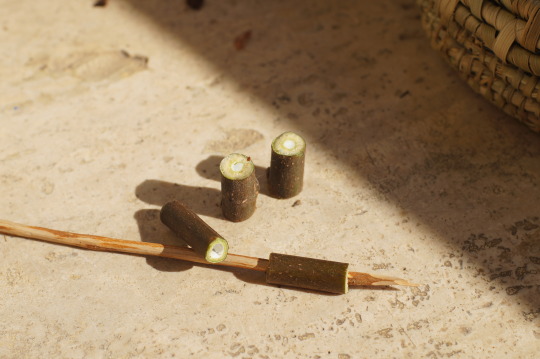
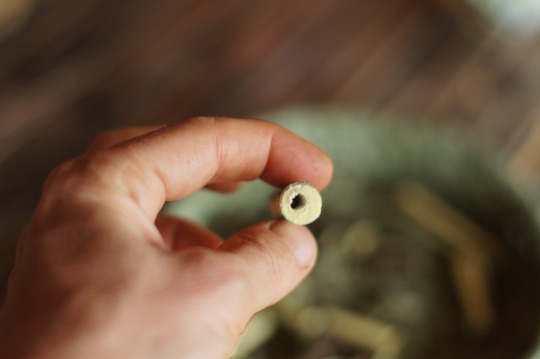
You can make stripes by stripping some of the green bark with a knife.
//
İsterseniz bıçakla dış kabuğu soyarak çizgiler yapabilirsiniz.

If you liked what you read, you can support me by buying me a coffee here
Eğer okuduklarınız hoşunuza gittiyse buradan bana bir kahve alarak destek olabilirsiniz.
#figtree#wooden beads#handmade#woodwork#sustainable living#eco crafts#sustainable crafts#incir ağacı#boncuk yapımı
3 notes
·
View notes
Text
Growing Plants from Cuttings // Çelikle Bitki Çoğaltma
Whenever I see a plant I like I just take a little cutting about 10 cm long with at least 2 eyes on it and stick it in a pot filled with loose soil. I make sure to keep the soil moist at all times.
The chances of rooting of the cutting will depend on the time of the year you take it. For trees and bushes the best time is when they go dormant. So when they wake up in spring they keep on with their natural rhythm of growing, no matter where they are!
For herbs like lavender,rosemary etc. spring is a good time.That’s when they have new growth which can root easily. But from experience, I can say that fall is a good time too. The only thing is that you have to take care of the rooted plants at home or a greenhouse until planting out in spring .
////
Ne zaman hoşuma giden bir bitki görsem hemen ondan yaklaşık 10 cm’lik bir çelik alırım ve geçirgen toprakla dolu bir saksıya batırırım.Çelik alırken dikkat edilecek şey dalın üzerinde birkaç göz olması, çünkü yeni yapraklar oradan çıkıyor.
Çeliklerin köklenme ihtimali çeliği aldığınız zamana göre değişiyor.Ağaçlar ve çalılar için en iyisi uykuya geçtikleri zaman. Böylelikle baharda uyandıklarında,sizin onların bir parçasını köklendirdiğinizden habersiz, kendi doğal ritimlerinde büyümeye başlıyorlar!
Lavanta ve biberiye gibi aromatik otlar içinse, yeni filizler verdikleri bahar daha iyi bir zaman. Ama tecrübeme dayanarak sonbaharın da uygun bir zaman olduğunu söyleyebilirim.Sadece köklendirdiğiniz bitkilere bütün kış, baharda dışarıya dikeceğiniz zamana kadar, evde ya da serada güzelce bakmanız lazım.
-------------------------------------------------------------------------------------------------
Sambucus Nigra (Elderberry) // Mürver

January 1 // 1 Ocak
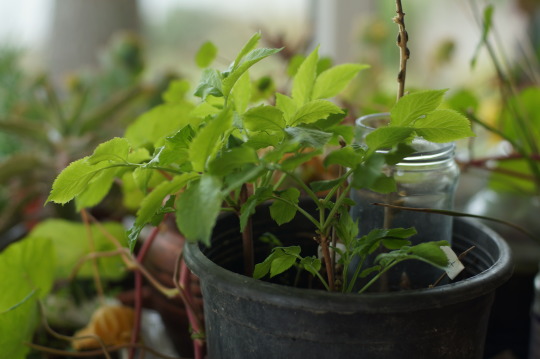
January 30 // 30 Ocak
-------------------------------------------------------------------------------------------------
Blackberries // Böğürtlenler
These are a couple of different variety of blackberries.Some of them are the thorny wild ones, some of them are thornless ones that I took during my daily walks around the neighborhood.
They were all looking like pieces of sticks, but now they shot out some leaves!
It’s time to divide them in their own individual pots, because by the color of the leaves it looks like they have a bit of nutrition deficiency.
///
Fotoğtafta birkaç çeşit böğürtlen var.Bazıları dikenli yabani olanlardan, bazıları da dikensiz evlerin çitlerine sardırılmış olarak gördüklerimden.
Çelikler birkaç parça çubuk gibi görünüyorlardı, ama şimdi hepsi yapraklandı.Artık onları ayrı saksılara aktarma zamanı geldi.Çünkü yaprakların renginden besin yetersizliği çekiyorlar gibi görünüyor.
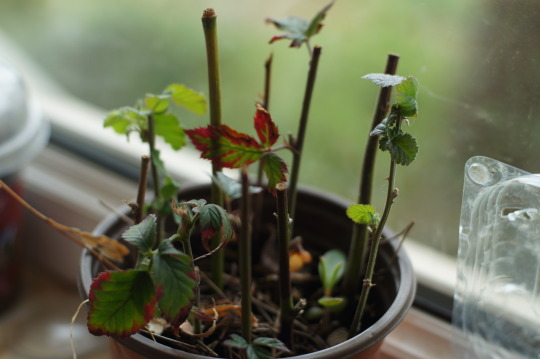
-------------------------------------------------------------------------------------------------
Argyranthemum frutescens (Marguerite Daisy) // Çalı Papatya
I took some cuttings of semi/hard shoots (woody on the bottom, green on top) which where growing from the bottom of the plant. They quickly grew larger and in a month or so started to flower at the same time as the mother plant. Now they are ready to plant out, but I rather wait for the weather to get a little warmer (it’s snowing now!).
///
Çalı papatyanın dibinden çıkan yarı odunsu (alt tarafı odunlaşmış,üst tarafı yeşil) filizlerden aldığım çelikler. Bir ayda çabucak büyüdüler ve ana bitkiyle aynı anda çiçek açmaya başladılar. Artık dışarıya ekilebilirler ama havanın biraz daha ısınmasını beklemek daha iyi olacak (şimdi kar yağıyor!)
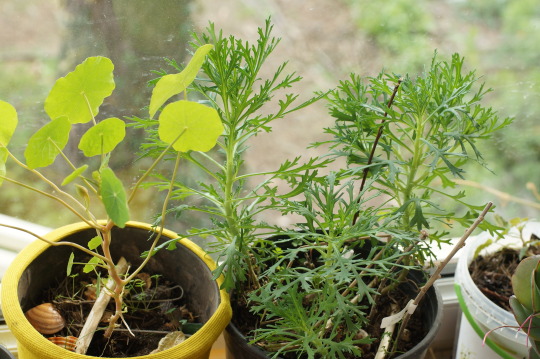
January 30 // 30 Ocak
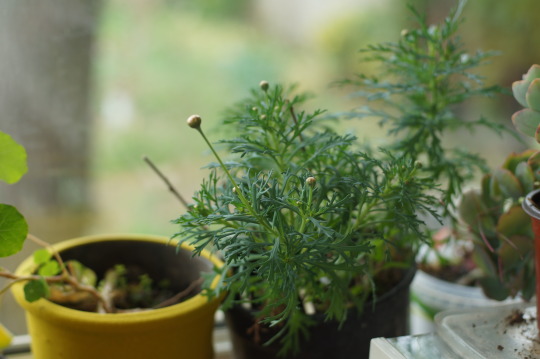
February 23 // 23 Şubat
If you liked what you read, you can support me by buying me a coffee here
Eğer okuduklarınız hoşunuza gittiyse buradan bana bir kahve alarak destek olabilirsiniz
#cutting#growing#plants#growing plants#perennial plants#taking cuttings#elderberry#organic gardening#permaculture gardening#permaculture#bitki çoğaltma#çelik alma#mürver#papatya#böğürtlen
22 notes
·
View notes
Text
Garden in February
Spinach that I sowed at the end of September are going strong. They endured snow and freezing weather!
//
Eylül sonunda ektiğim ıspanaklar,kara ve dona dayanıp iyice güçlendiler!

Broccoli is fruiting ,
//
Brokoliler çıkıyor,
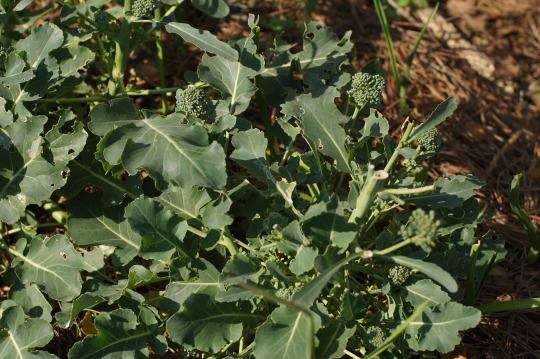
Swiss chard’s leaves are getting larger,
//
Pazının yaprakları büyümeye başladı,
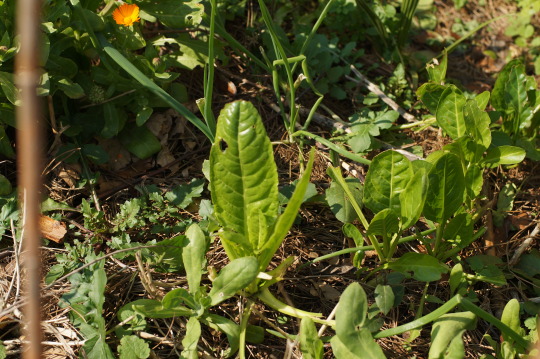
Fennel is giving out new shoots which are delicious in salad!
//
Rezene yeni filizler veriyor.Salatada çok lezzetli oluyor!
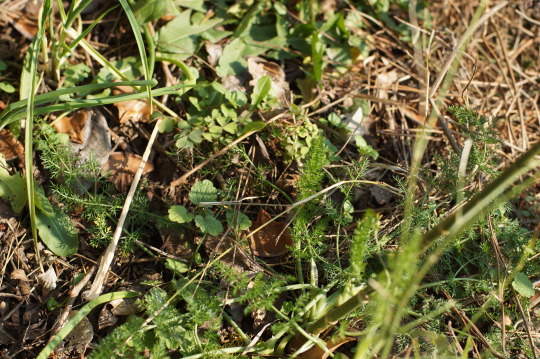
Daffodils are blooming!
//
Nergisler açıyor!

Kale is there whenever we need it!
//
Ne zaman ihtiyacımız olursa karalahana hazırda bekliyor!

Garlic and onions are growing,
//
Sarmısak ve soğanlar büyüyor,

Wild lavender (lavandula stoechas) is just about to bloom. I gathered its seeds from the Aegean Coast of Turkey where I used to live. Their scent is the calling of spring!
//
Karabaş otu çiçeklenmek üzere.Tohumlarını,heryerde yanımda olsunlar diye Cunda’da yaşarken toplamıştım.Kokusu baharın habercisi benim için!

Crocus is in flower!
//
Çiğdemler çiçek açıyor!
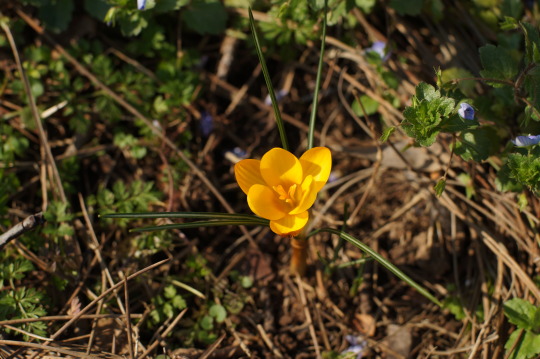
Broad beans are flowering also! Couple of weeks ago they stayed under the snow for 2-3 days.I was worried that they would freeze, but other than a couple of darkened leaves they’re all healthy and strong!
//
Bakla da çiçekte! Bir iki hafta önce kar altında kaldılar ama birkaç kararmış yapraktan başka bir hasara uğramadan kurtardılar kendilerini!
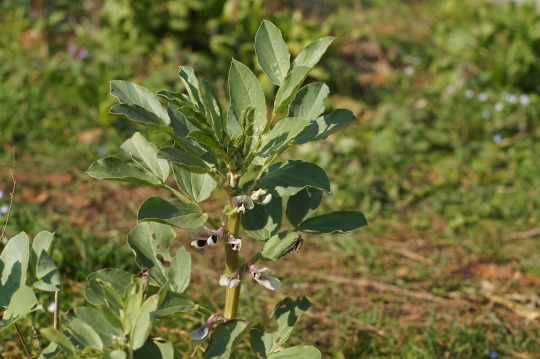
Wild oregano is giving out new shoots.
//
Orhanlı kekiği yeni filizler vermeye başladı.
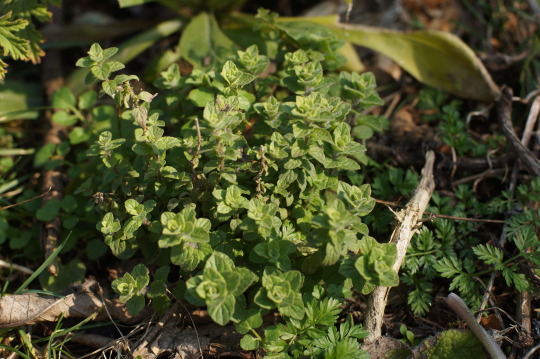
As always, calendulas are in bloom!
//
Her zaman olduğu gibi aynısefalar çiçekte!
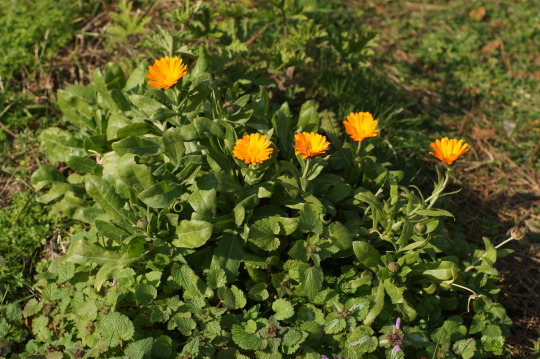
#gardening#permaculture#wintergardening#swiss chard#kale#calendula#lavandulastoechas#broccoli#organicgardening#sustainableliving
4 notes
·
View notes
Text
Wild Salad Greens
As I got to know and recognize the wild plants that pop up all over, I realized how much more beneficial they are than the domesticated greens. A lettuce for example is deprived of most of its minerals and vitamins for the sake of being palatable and not bitter as its ancestors.
Here are some of the edible wild greens I see coming up year after year in my garden:
//
Etrafımdaki yabani otları tanımaya başladığımdan beri, onların evcilleştirilmiş yeşilliklerden ne kadar daha fazla yararlı olduklarının farkına varıyorum. İşte her sene bahçemde tekrar tekrar çıkan yabani otlardan bazıları:
1.Lamium Purpureum // Dead Nettle --- Ballıbaba
This plant keeps coming back to our garden in the beginning of winter. From February to April it blooms beautiful purple flowers that bees love.
To use in salads I pinch the tops and gather two hands full of it. It tastes earthy and has a wild aroma to it.
//
Bu ot her kış başında bahçemizde çıkıyor. Şubat'tan Nisan ortasına kadar arıların çok sevdiği mor çiçeklerini açıyor.
Salatada kullanmak için uçlarını kopartarak 2 avuç dolusu topluyorum. Tadı topraksı ve yabani bir aromaya sahip.
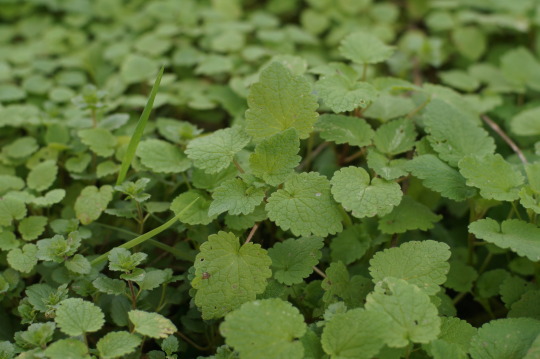
2.Plantago Major // Broadleaf Plantain -- Sinirli Ot
I gather its young leaves here and there and toss them into the salad mix. It doesn’t have a dominant taste but provides lots of vitamins and minerals.
Also whenever I cut my hand or get stung by a bee, I chew one of its leaves and press it onto the cut or sting. It quickly takes away the pain and helps the healing process.
///
Genç yapraklarından toplayıp salata karışımına ekliyorum. Pek öne çıkan bir tadı yok ama içinde birsürü vitamin ve mineral var.
Bir de ne zaman elimi kessem veya arı soksa, yapraklarını çiğneyip üzerine koyuyorum.Hemen acıyı alıyor ve iyileşme sürecine yardımcı oluyor.

3.Daucus Carota // Wild Carrot -- Yabani Havuç
We have a couple of wild carrot varieties in our garden that pop up in the beginning of the winter.
This one tastes similar to parsley but fresher!
//
Bahçede her kış başında filizlenen birkaç tane yabani havuç çeşidi var. Bu çeşit maydonoza benziyor ama daha taze bir tadı var!
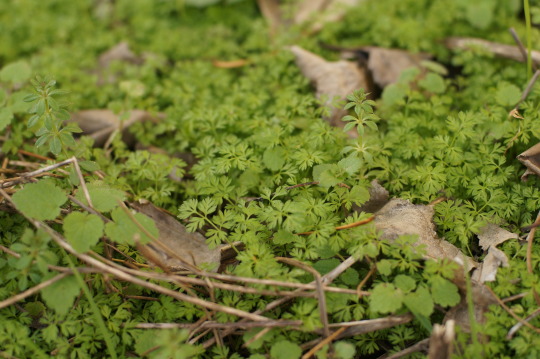
4.Malva Sylvestris // Mallow -- Ebegümeci
Mallow also dyes back in summer and comes back in winter.It has a strong root system, so I just leave it where it is (even if it’s in the middle of the vegetable bed), and let it to its own thing!
I gather young leaves and chop them up into the salad. It tastes similar to spinach and somewhat like okra because of its mucilaginous properties.
It has many vitamins and minerals and also has benefits to joints.
///
Ebegümeci yazın kuruyor ve kışın köklerinden tekrar canlanıyor. Güçlü bir kök sistemi olduğu için nerede çıktıysa onu orada bırakıyorum (sebze yatağının tam ortasında olsa bile!).
Taze yapraklarını toplayıp, ince kıyarak salataya ilave ediyorum. Tadı ıspanağa ve biraz da bamyaya benziyor.
Birçok vitamin ve mineralle dolu, aynı zamanda da eklemlere iyi geliyor.
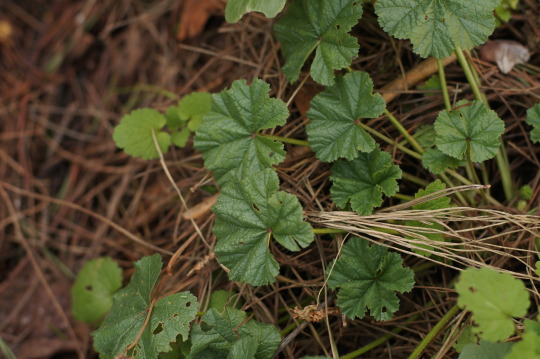
5.Taraxacum Officinale // Dandelion -- Karahindiba
And of course dandelion! A plant that accompany me everywhere I go. It has so many benefits and vitamins,minerals that it begs us to eat it!
I gather young leaves, chop them up and toss them into the salad.
After I mix all the herbs/plants together, I make a dressing of olive oil,lemon and salt, pour it in the salad and with clean hands I mix it all in. Salt gets the bitterness out of dandelion greens.
////
Ve tabii ki karahindiba! İşte nereye gidersem yanımda olan bitki. Kendisi o kadar faydalı ki heryerde karşımıza çıkıp bize beni ye diyor!
Taze yapraklarını toplayıp, ince keserek salataya ilave ediyorum.
Bütün otları karıştırdıktan sonra, zeytinyağı,limon ve tuzu iyice karıştırarak bir sos hazırlıyorum ve temiz ellerle sosu salataya iyice karıştırıyorum. Tuz karahindibanın acısının çıkmasını sağlıyor.
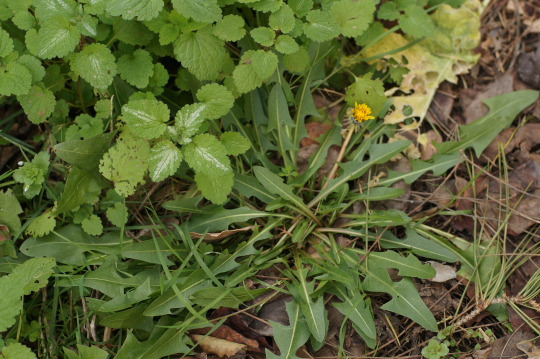
Happy eating!
Afiyet olsun!
#foraging#wild greens#wild salad#salad from the wild#dandelion#taraxacum officinale#sustainable living#winter greens#organic gardening#permaculture#malva#dead nettle#Lamium purpureum#growing#malva sylvestris#plantago major#broadleaf plaintain
13 notes
·
View notes
Photo








Making a Rib Basket
We have virginia creeper and honeysuckle on our front fence that grew wildly over the past spring and summer. So after I pruned them, I removed the bark of honeysuckle and carefully coiled them. Then I started experimenting on making baskets.
This kind of basket which is also called an egg basket is quite fun to make. The only thing is that it requires extremely flexible vines, because of the tight turns.
I used all the vines fresh, therefore a couple of weeks later they shrank a little bit. Usually you have to dry the vines and moisten them prior to weaving. I will try that too!
After all there’s nothing to be afraid of starting to make baskets! There’s so much material around, and you just have to experiment and see which vines are suitable for which projects.
20 notes
·
View notes
Photo





Dyeing Wool with Virginia Creeper ( Parthenocissus quinquefolia )
Our front fence is covered with Virginia creeper (which I mistakenly thought was hedera helix).Now that it’s fall, we pruned it as it grew vigorously during summer.
With all the leaves and berries leftover from the plant, I got my hands on dyeing!
-I filled a stainless steel pot with the leaves and berries,
-added rainwater,
-simmered for about 40 minutes,
-with the plant material left in pot, added alum mordanted wool skeins,
-simmered for additional 40 minutes or so,
-left the pot overnight to cool.
The color turned into a lovely bright green-yellow.
Amerikan Sarmaşığı ( Parthenocissus quinquefolia ) ile Yün Boyamak
Bahçemizin ön duvarı Amerikan sarmaşığıyla kaplı.Yazın o kadar büyüyüp, her tarafa kollar atmış ki, artık kendisini budama zamanı geldi.Sonbahar bu işi yapmanın iyi bir zamanı.
Tabii ki arda kalan yapraklar ve meyvecikleri öylecene bırakamazdım.Hemen kolları sıvayıp boya yapma işine koyuldum!
-Çelik tencereyi yapraklar ve yemişlerle doldurdum,
-yağmur suyu ekledim,
-40 dakika kısık ateşte kaynattım (fokurdamayacak şekilde),
-bitkileri süzmeden,daha önceden şapla mordanladığım yün çilelerini ekledim,
-ara ara karıştırarak bir 40 dakika daha kaynattım (fokurdamayacak şekilde),
-tencereyi gece soğumaya bıraktım.
Ortaya sarıyla yeşil arası parlakça bir renk çıktı.
#dyeing#natural dye#plant dye#sustainable#virginia creeper#wool#dyeing wool#nontoxic#natural#sustainable living#craft#dye plants#doğal boyama#yün boyama#amerikan sarmaşığı
6 notes
·
View notes
Photo




Seed Saving
2.Calendula Officinalis (Pot Marigold)
When the flower closes, slowly the seeds will start to form ( all the little curls you see on the photos are seeds). Once they are dry, wrap them in paper and save them in a dry place.
If you leave calendula on its own, it will drop its seeds on the soil around it and new sprouts will come out! You can then transfer the seedlings elsewhere in the garden. It will save you time and effort to grow new plants!
////////
Tohum Saklama
2.Calendula Officinalis (Aynısefa)
Çiçekler kapandığında yavaş yavaş üzerinde tohumlar oluşmaya başlar (fotoğraflarda gördüğünüz her küçük kıvrımlı parça birer tohumdur).Çiçek başları tamamen kuruduğunda, ya bütün olarak ya da her bir tohumu ayırarak bir kağıda sarın ve kuru biryerde saklayın.
Eğer aynısefayı kendi başına bırakırsanız,etrafına tohumlarını saçar ve dibinde yeni yeni filizler çıkar. Bu filizleri daha sonra bahçenin başka yerlerine taşıyabilirsiniz.
#calendula officinalis#pot marigold#saving seeds#seed saving#sustainable gardening#permaculture#gardening#flower#growing flowers#growing
11 notes
·
View notes
Photo





Seed Saving
1.Tagetes Patula (French Marigold)
Saving seeds of French marigold is quite easy. Once one of the flowers dry up , you can pick it and save the seeds that form inside the flower.
You can either save the seeds by wrapping them in paper or you can save the whole flower with the seeds inside.The important thing is that the flower should be totally dry.
One flower contains so many seeds that you can share it with your friends and neighbours!
////////////////////////////
Tohum Saklama
1.Tagetes Patula (Kadife Çiçeği)
Kadife çiçeğinin tohumlarını saklamak oldukça kolay. Çiçeklerden herhangi bir tanesi kuruduğunda koparın ve içinde oluşan tohumları saklayın.
İster tohumları çiçeğin içinden çıkarıp, bir kağıda sarın, ister çiçeği olduğu gibi kuru bir yerde saklayın. Önemli olan çiçeğin tamamen kurumuş olması ve içindeki tohumların alt kısımlarının siyah olması.
Bir çiçeğin içinde o kadar çok tohum oluyor ki arkadaşlarınızla ve komşularınızla paylaşabilirsiniz!
#tagetes patula#kadife çiçeği#seed saving#organic gardening#permaculture#permaculture gardening#growing
51 notes
·
View notes
Photo






Herbal Mosquito Repellent
Here's a recipe I learned from @capraecavoli . I tried it right away and it works very well!
Collect a handful of
-sage
-lavender
-rosemary
-lemon balm or lemon verbena
-geranium or pelargonium graveolens
Don't worry if you don't have them all, use whatever you have in hand. -Put them in a clean glass jar.Cutting them into small pieces helps extracting more of the plant essence.
-Add white vinegar or any vinegar with 5% acidity until you cover all the plant material.
-Close the lid, put it in a dark cool place and wait 1-2 weeks
-Strain the vinegar through a strainer or a cheesecloth and pour it in a spray bottle.
That's it!
///////// Bitkisel Sivrisineksavar İşte internette @capraecavoli 'den öğrendiğim bir tarif! Hemen uyguladım ve çok etkili olduğu için burada paylaşıyorum.
Birer avuç dolusu
-adaçayı
-lavanta
-biberiye
-melisa (melissa officinalis veya aloysia triphylla)
-ıtır toplayıp temiz bir kavanoza koyun. Bitkileri ufak parçalara bölün ki özleri daha iyi çıksın.
-Üzerine bitkileri örtecek şekilde beyaz sirke veya %5 asiditesi olan herhangi bir sirke ekleyin
-Kapağını kapatıp serin ve karanlık bir yerde 1-2 hafta bekletin
-Bir tülbent veya süzgeçle sirkeyi süzün ve temiz bir sprey şişesine aktarın.
İşte bu kadar!
#herbal#DIY#homemade#vinegarette#doğal#kendinyap#evyapımı#growing#sage#lavender#lemon verbana#rosemary#aromatic herbs#sivrisinek savar#mosquito#mosquito repellent
6 notes
·
View notes
Photo





Ways to Protect Seeds and Seedlings from cats,slugs etc..
When I started sowing seeds in the early spring when the weather was still chilly, I realized that I have to protect them from our kittens who tend to dig wherever there is beautiful open soil. Also slugs and snails love the newly sprouted seedlings. So I had to find a way to protect them!
As I was trying to figure out how to weave baskets, I made frames with pruned branches and wove around them roughly with ivy and grape vines. I placed them where I sowed the seeds and waited for them to sprout!
I also found a small metal basket at home and just placed it where I sowed seeds.Its holes were big enough so that I kept it in place until the seedlings got stronger. I lost 2 of them to snails but it worked for kittens!
Another protection way that I use the most is plastic water containers cut in half.Sometimes wind blows them away, so just put a stone on top to keep it in place.
Tohumları Kedilerden,Sümüklüböcek vb.’den Korumanın Yolları
Bazı bitkilerin tohumlarını direkt toprağa ekince daha iyi büyüyüp gelişiyorlar.Ama bahçede hoplayıp zıplayan, gördüğü her tavlanmış toprağı kazan kediler olunca bu iş pek te kolay olmuyor! Bir de buna yeni çıkan filizleri yemeyi çok seven sümüklüböcekler de eklenince iş iyice zorlaşıyor.
Tam da sepet yapmayı yeni yeni öğrenirken, budanmış dallar ve sarmaşıklardan yuvarlak çerçeveler yapıp yeni tohum ektiğim yerlerin üzerine koydum. Filizlerden 2 tanesini sümüklübocekler yedi ama kedilerden kurtuldular!
Başka bir yere de evde bulduğum ufak metal bir sepeti koydum.
Çok kullandığım başka bir yöntem de ikiye kesilmiş 5lik damacanalar. Rüzgarda uçabiliyorlar ama üzerine bir taş konursa yerli yerinde durur.
#seedlings#direct sowing#planting#growing#protecting seedlings#organic gardening#sustainable living#kitten
24 notes
·
View notes
Photo

Polyculture Gardening
Instead of planting plain rows of single vegetables, I prefer to plant mixed vegetables according to companion planting principles. This way the plants are not left vulnerable to pest and diseases. I also try to leave some of the wild edibles in place, such as mallow that sprouted in winter and its thriving! It’s a wonderful edible and medicinal plant. Also I have plantain (plantago major) in many places in the garden which I leave alone.
Another benefit of the wild plants is that they serve as a trap crop for pests. Something that I observed in the beginning of summer is that colonies of aphids in chicories attracted ladybugs which are their natural predator. This way if aphids get into our vegetables, ladybugs are already present in the garden to eat them away! If in the beginning,we have gotten ridden of chicories and aphids, ladybugs would have no time to come into our garden when aphids would’ve been all over our vegetables.
Polikültür Bahçecilik
Sebzeleri tek tek sıralar halinde dikmektense, ben kardeş bitkiler prensibine uygun olarak karışık ekim yapmayı tercih ediyorum.Bu şekilde ekilince bitkiler zararlılara karşı yalnız başlarına savunmasız kalmamış oluyorlar.Sebzelerin arasında yenebilir yabani bitkiler çıktıysa onları yerinde bırakıyorum.Mesela kışın sebze yatağında filizlenen ebegümeci, bütün kış bize yapraklarını yiyecek olarak ikram etti, şimdi de çiçeklerini kurutup, tıbbi bitki çayları yapmak için saklıyoruz.
Yabani bitkilerin bir diğer faydası da zararlı böceklere kapan oluşturmaları. Yaz başında gözlemlediğim üzere, hindibalar üzerinde kolonileşen yaprak bitleri, onları yiyen uğurböceklerinin bahçemize gelmesine sebep oldular. Böylelikle yaprak bitleri sebzelere bulaşırsa, doğal yoldan uğurböcekleri onları yiyip yok edebilecekler.Eğer en baştan yaprak bitlerini yok etseydik, ya da hindibaları bahçemizde bırakmasaydık, bu sefer yaprak bitleri direkt sebzelere geleceklerdi ve uğurböcekleri gelene kadar iş işten geçecekti.
Tomatoes, Carrots, Catnip and Zucchini
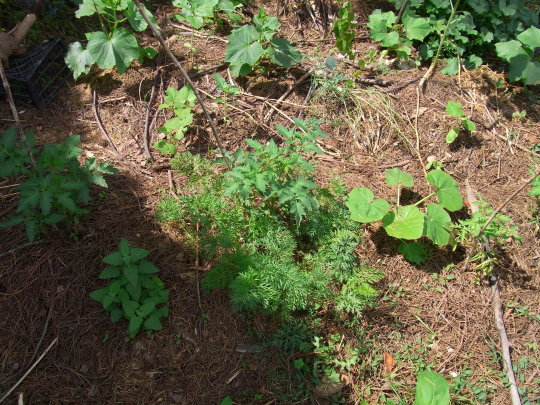
I sowed carrot seeds towards the end of March when the weather was still chilly.I put a cover on top and waited for them to sprout. When the weather warmed up I removed the cover and planted a tomato seedling in the middle of carrots. When tomato will grow, it will provide shade to carrots , while carrots will open up the soil with its tap root. Also carrots need low nitrogen to grow which creates a balance with nitrogen hungry tomatoes.
I planted catnip near them. ‘’It deters flea beetles, ants, aphids, weevils, cabbage white butterflies, and mice. It’s flowers attract many bees, hoverflies, and other pollinators. It also attracts parasitic wasps making catnip a very useful plant for the organic gardener ‘’(source).
Zucchini next to tomatoes make a good ground cover.
Domates,Havuç,Kedi Nanesi,Kabak
Mart’ın sonunda doğru hava hala soğukken havuç tohumlarını toprağa ektim ve üzerlerini örtüp filizlenip, birazcık büyümelerini bekledim.Havalar ısındığında örtüyü kaldırdım ve aralarına bir domates fidanı ektim. Domates büyüdüğünde serinlik seven havuçlara gölge yapacak, havuçlar da kökleriyle toprağı gevşetecek.Bunun yanında domateslerin aksine havuçların büyümek için fazla nitrojene ihtiyaçları olmadığı için iki bitki arasında sağlıklı bir denge oluşacak.
İkisinin yakınına birçok zararlı böceği uzaklaştıran ve yararlı polenleyici böcekleri çeken kedi nanesi diktim.
Domateslerin yanına da kabakları diktim ki kocaman yapraklarıyla toprağı gölgeleyip, kurumasını engellesinler.
Calendula,Tomato, Onion, Lettuce
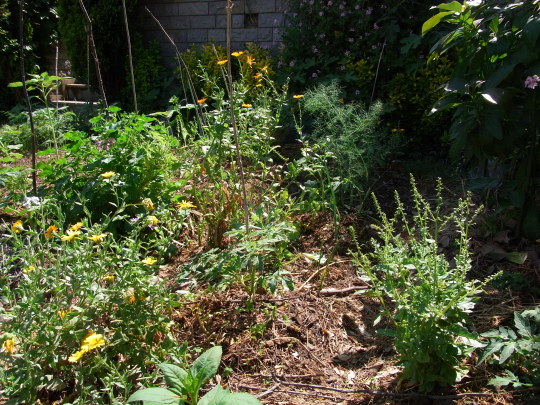
Calendula attracts pollinators and deters some pests.It can work as a trap crop by attracting pests such as aphids to itself rather than the vegetables. In my garden it self seeds and I have too many of them.Sometimes I just cut and drop them as mulch.
Onions next to tomatoes deter aphids and makes good use of space.
Lettuce benefits from the shade that tomatoes provide and it covers the soil underneath keeping it moist.
Fennel as I read everywhere, fennel is a allopathic plant that doesn’t have any companions.But I had one growing in the bed since last year, and I let it stay there and see that happens!
Aynısefa,Domates,Soğan,Marul,Pazı
Aynısefa güzel çiçekleriyle polenleyici böcekleri kendine çeker ve bazı zararlıları uzaklaştırır, ayrıca yaprak bitleri için kapan bitkisi olarak kullanılabilir. Bizim bahçede kendi kendini tohumluyor ve topraktan sürekli yeni filizler çıkıyor.Ben de bu filizleri bahçenin her tarafına taşıyorum.
Soğan domateslerin yanına dikildiğinde yaprak bitlerini uzaklaştırır ve ayrıca boşlukları doldurarak yerden tasarruf sağlar.
Marul domatesin sağladığı gölgeden yararlanır ve altındaki toprağı örterek nemli kalmasını sağlar.
★Dikkat edilecek bir nokta: soğan ve marul hava ısınınca hemen tohuma kaçar,bu yüzden toprağı nemli tutmaya dikkat edin ve domatesin gölgesinde kaldıklarından emin olun.
Rezene (arapsaçı) Birçok yerde rezenenin yanındaki bitkilere iyi etkisinin olmadığını okumuştum.Ama sebze yatağında halihazırda geçen seneden beri büyüyen bir rezene vardı ve onu olduğu yerde bıraktım.Bakalım neler olacak!
Pazı Fotoğrafta da görebileceğiniz gibi yatakta geçen seneden tohuma kaçmış bir pazı zaten var. Boş bulduğum yerlere tohum ilave ettim.Geçen sene gözlemlediğim kadarıyla pazılar domatesin yanında güzel büyüyorlar.Onlar da gölge ve serin hava seviyorlar.Domatesin kocaman tacı da bunu fazlasıyla sağlıyor.
Mallow (Malva sylvestris)
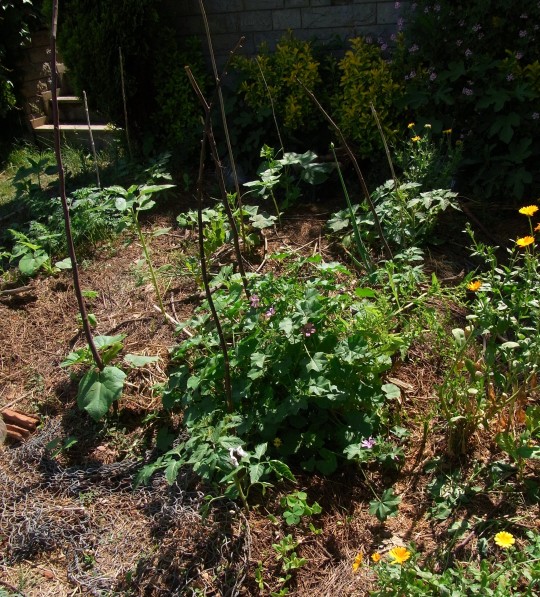
Mallow found a perfect spot for itself in winter. We ate a lot of it in stir fries and soups. It grew so much that I had to cut it back.It still grows happily, new tender leaves are coming out each day which means food for us! It also has many medicinal uses and its beautiful flowers attract many pollinators including butterflies. So I left it where it is and I planted my tomato seedlings on either side of it.
Ebegümeci
Kışın ebegümeci kendine çok güzel bir yer buldu.Taze otun pek olmadığı zamanlarda yapraklarını kavurduk, çorbalara koyduk.Artık o kadar çok büyüdü ki birazını budamak zorunda kaldım! Hala mutlu bir şekilde büyüyor,her gün yemeklik taze sürgünler veriyor. Birçok tıbbi kullanımının yanında güzel çiçekleri kelebekleri ve polenleyici yararlı böcekleri çekiyor. Onu olduğu yerde bırakıp domates fidelerini her iki yanına diktim.
Cucumbers,Sunflowers and Pole beans
On the left row, I planted cucumbers and sunflowers together thinking that cucumbers will climb on sunflowers.On the empty spots I just stuck some bean seeds so they will also climb on sunflowers and will feed the soil with nitrogen.
Salatalık,Ayçiçeği ve Yerelması
Soldaki sıraya salatalık ve ayçiçeğini beraber diktim.Böylelikle salatalıklar ayçiçeğine tırmanabilecekler.Boş kalan yerlere fasulye tohumları ektim.Onlar da hem ayçiçeğine tırmanabilecekler hem de toprağa nitrojen vererek besin sağlayacaklar.
Sunchokes for Edging

All around the edges I planted sunchokes (or jerusalem artichokes). I just bought half kilo of them in the market and planted them in mid-March.They sprouted about after a month.
They grow very tall, are perennial, have beautiful flowers and will be a living fence! We have many cats in the garden and it will be nice to have some kind of barrier for them.
Kenarlara Yerelması
Pazardan yarım kilo yerelması aldım ve Mart ortasında sebze yatağının dış kenarlarına çit niyetine ektim.Yaklaşık 1 ay sonra filizlendiler, yavaş ve sağlam bir şekilde büyüyorlar.
Yerelmasının ayçiçeği gibi çiçekleri oluyor ve boyları upuzun oluyor, yani yaşayan bir çit! Bahçede birsürü kedimiz olduğu için onlar için iyi bir bariyer olacak.
Pumpkin in the Corner
I planted a pumpkin seedling in the corner so it can spread outside and have as much space as it wants while keeping the soil covered and moist.
Köşede Balkabağı
Dış köşeye balkabağı ektim ki dışarıya doğru istediği kadar büyüsün ve yapraklarıyla altındaki toprağı nemli tutsun.
#companion planting#polyculture#permaculturegarden#gardening#spring garden#summer garden#Growing Vegetables#growing#self sustainable#sustainable living#sustainable gardening#calendula#tomatoes#carrots#pumpkin#catnip#permakültür#permakültür bahçeciliği#permakültür bahçecilik#organik#doğal yaşam#sürdürülebilirlik#kendine yetmek#kardeş bitkiler#karışık ekim#yaz bahçesi#sebze#yaz sebzeleri
46 notes
·
View notes
Photo


Before and After
2 years ago we planted a plum tree in this empty spot in our garden.Then we added 2 rosemary plants and a lavender to the edges, a rasberry in the middle, and scattered some calendula seeds around. Now it’s a thriving tree guild!
Önce ve Sonra
2 sene önce bahçenin bu boş köşesine bir mürdüm eriği ağacı diktik.Sonra kenarlara 2 tane biberiye ve bir lavanta ortaya bir ahududu ekledik, boşkuklara da aynısefa tohumları saçtık.Şimdi coşkulu bir ağaç birliğimiz var!
#tree guild#permaculturegarden#gardening#polyculture#perennial plants#sustainable gardening#sustainable living#growing
5 notes
·
View notes
Text
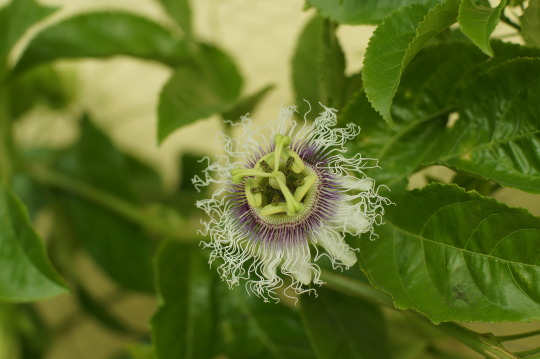
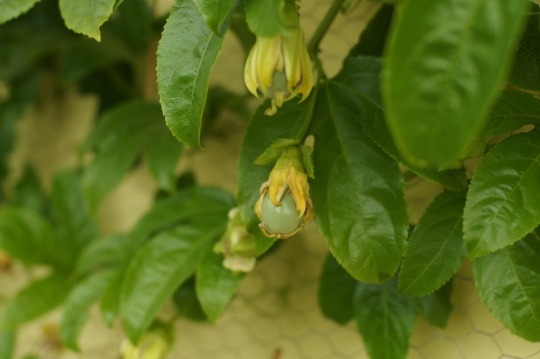

Passiflora Edulis // Passionfruit
While living in Thailand passionfruit was one of my favorite fruits.After coming back to Turkey I realized that passiflora incarnata is grown as an ornamental plant in the gardens of many coastal towns.So I thought why not grow passionfruit? I found a seedling at a nursery and planted it by the house. It was growing slowly in its first year,but the year after it bore many delicious fruits!
I took photos of the growing fruits as well as its beautiful flower yesterday May 28.
Çarkıfelek Çiçeği ve Meyvası (Passiflora Edulis)
Tayland'da yaşarken çarkıfelek en sevdiğim meyvelerden birisi olmuştu. Türkiye'ye döndüğümde passiflora incarnata'nın sahil kasabalarında süs bitkisi olarak yetiştirildiğini farkettim ve dedim ki niye passiflora edulis yetiştirmiyorum? Çeşitli araştırmalarım sonucu bir fideciden fidesini buldum ve evin yanına diktim. İlk sene biraz yavaş büyüdü ama ikinci sene yerine alıştı ve birsürü meyve verdi!
Meyvesinin gelişme aşamalarının ve dünya güzeli çiçeğinin fotoğraflarını dün (28 mayıs) çektim.
#passiflora edulis#passionfruit#çarkıfelek çiçeği#sustainable gardening#sustainable living#tropical fruit#fruit#flower#growing#self sufficiency
2 notes
·
View notes
Text




Bean Teepee
We made a bean tipi out of discarded aluminum poles. It's quite simple to make it. Just tie the poles on top and bury them a little bit in the soil so they are stable.
We made the tipi first and then prepared the soil around it for the beans. It can be made the other way around too, so the poles will be right in the planting soil. Ours left out a bit far from the poles.
After beans sprouted we wrapped cotton yarn around the poles so beans can easily climb up.
Now it's time to wait!
Fasulye Tipisi
Kullanılmayan alüminyum sopalarla bir fasulye çadırı yaptık.
Yapması oldukça kolay.Sopaları tepeden bağlayın ve alt kısımlarını birazcık toprağa gömün ki yerinde sağlamca dursun.
Biz önce sopaları sabitleyip sonrasında toprağı ekim için hazırladık.Ama tam tersi de yapılabilir ve sopalar ekim toprağına sabitlenebilir. Bizim toprağımız sopalardan biraz uzakta kaldı, ama hafif bir yönlendirmeyle fasulyeleri sardırabiliriz.
Fasulyeler filizlendikten sonra sopaların etrafına pamuklu ip doladık ki fasulyeler kolayca tırmansınlar.
Şimdi bekleme zamanı!
#bean tipi#bean teepee#bean tepee#growing#beans#green beans#gardening#sustainable#permaculture#spring gardening
31 notes
·
View notes
Text

Making a Tree Guild
For the past year I've been working on turning our family house's lawn garden into a self sustained permaculture garden. The physical work and energy that goes into tending lawn is incredible. In addition it needs a lot of water to keep it green all the time!
It's hard work to get rid of lawn at once. So I started making circles around the fruit trees and planting perennials.
////
Ağaç Birliği Oluşturmak
Bir seneye yakın bir süredir aile eviminizin çim bahçesini kendi kendine yeten bir permakültür bahçesine çevirmeye uğraşıyorum.
Çim bakımına harcanan fiziksel güç ve enerji inanılmaz dercede fazla! Üstüne üstlük çimi her daim yeşil tutmak için fazlasıyla su harcamak gerekiyor.
Çimden birdenbire kurtulmak çok zor olduğu için ben de meyve ağaçlarının etrafında günden güne genişleyen daireler açarak çok yıllık bitkiler ekmeye başladım.
1.COMFREY // Karakafes Otu
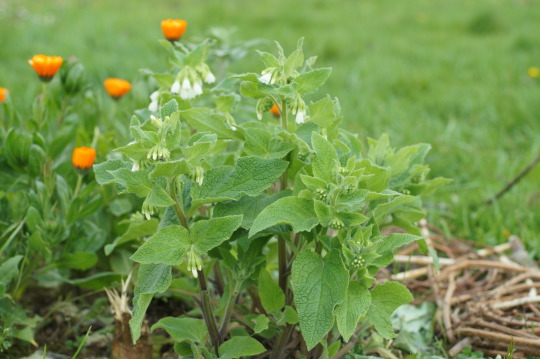
I heard about the benefits of comfrey a lot while reading about permaculture,but there was no way I can find it here. While I was walking around I found a native comfrey which is Symphytum orientalis. The only difference from the officinale one is that this one has white flowers and has no medicinal uses. I uprooted a couple of them from the sidewalk and planted them around the trees. Now and then I tear the leaves to make a mulch full of minerals. Also when they flower in April bees love them!
////
Karakafes otunun faydalarını permakültür kitaplarında çokça kez okumuştum.Ama bizim buralarda onu bulmak oldukça zordu.Gelin görün ki çevrede yürüyüş yaparken yol kenarında yerel bir karakafes otu gördüm (symphytum orientale). Officinale'den yani kitaplarda bahsedilenden tek farkı çiçeklerinin beyaz olması ve herhangi bir tıbbi kullanımının olmaması. Hemen kaldırım kenarından bir iki tanesini söktüm ve ağaçların etrafına diktim. Arada bir yapraklarını kopartıp, mineral dolu bir malç olarak toprağın üzerine bırakıyorum. Bir de Nisan'da çiçek açtıklarında arılar coşuyor!
2. ARTICHOKE // ENGİNAR

While I was living in Ayvalık right across Mitilini, I got very familiar with artichokes as they're being grown so much around the area. They are a living mulch with their large leaves that keep the soil moist and a wonderfully beneficial vegetable. They give out suckers (in Turkish they're called bastards) which can be planted elsewhere in the garden.Once you have 1 plant you can have many more!
///
Ayvalık'ta yaşarken enginarı bitki olarak tanıma fırsatım olmuştu. Her bahçede mutlaka birkaç tane olurdu. Enginar kocaman yapraklarıyla toprağı nemli tutar, kuruyan yapraklarından malç yapılır, hem toprağa hem de insana faydalı güzel mi güzel bir bitki! Bir de yanlarından çıkan sürgünler (piç deriz biz) sökülüp bahçenin başka yerlerine ekilebilir. Yani, eve geldim bir tane , bahçeye ektim bin tane diyebiliriz!
3.DAFFODILS // NERGİS

Daffodils are flowers that are grown from bulbs. They hold moisture and prevent nutrients from washing away with rains .I found some bulbs online, but it took nearly a month for it to get here because of covid-19. But they were still in shape and I planted them right away in February. It took a little while to see the shoots and I had to protect them from our jumping kittens but they made it through and bloomed so wonderfully! They cheered up me and the bees in the gloomy cold days.
////////////////////////////////
Nergisler soğanlı bitki türlerindendir. Topraktaki nemi tutar ve besinlerin yağmurlarla topraktan akmasını önlerler. Nergis soğanlarını internetten ısmarlamıştım ama covid'den dolayı gelmesi 1 ayı buldu.Neyse ki hala ekilebilir durumdaydılar ve Şubat'ta soğanları kayısı ağacının etrafına ektim. İlk sürgünlerin çıkması biraz uzun sürdü ve onları hoplayıp zıplayan yavru kedilerimizden korumak için çeşitli numaralar bulmam gerekti ama sonunda çiçekler açtı! Karanlık soğuk Mart günlerinde çiçekler beni ve arıları çok mutlu ettiler!
4.CALENDULA // AYNISEFA
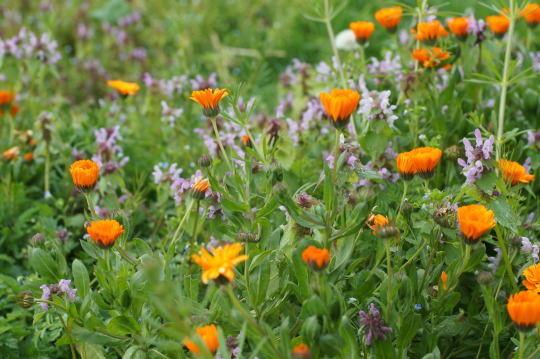
Another of my favorite plants!( I have a litttle blog post dedicated to its benefits,you can read it here) . It attracts beneficial insects and deters pests. It's a self seeding plant and new seedlings come up all the time.So I just move the seedlings wherever I want. The best part is that they bloom nearly all year long!
///////
En sevdiğim bitkilerden bir tanesi! Kendisinden burada bahsetmiştim. Yararlı böcekleri kendine çekip zararlıları uzaklaştıran bir çiçek. Aynısefa kendi kendini tohumladığı için devamlı etrafta yeni filizler çıkıyor, ben de onları bahçenin muhtelif yerlerine taşıyıp dikiyorum. İşin en güzel tarafı da neredeyse senenin tamamında çiçek açması!
5.WILDFLOWERS // YABANİ ÇİÇEKLER
Once I cultivated the soil underneath the trees, all kinds of native flowers came up. They're bees’ favorites, add color and joy to otherwise boring lawn, some of them are ground covers that spread prolifically and they need no special attention: they can take care of themselves!
///////
Ağaçların etrrafındaki çimi kaldırdığım ve toprağı çapaladığım için birer birer yerel çiçekler ortaya çıktı. Arılar bu işe çok sevindi! Çim varken monoton görünen bahçeye renk ve neşe geldi. Çiçeklerden bazıları yer örtücüler, yayıldıkça yayılıyorlar (çim alanını azaltmak için ideal bir özellik) ve kendi kendilerine yetip özel bir ilgiye ihtiyaç duymuyorlar!
Lamium Purpureum (dead nettle) // Ballıbaba
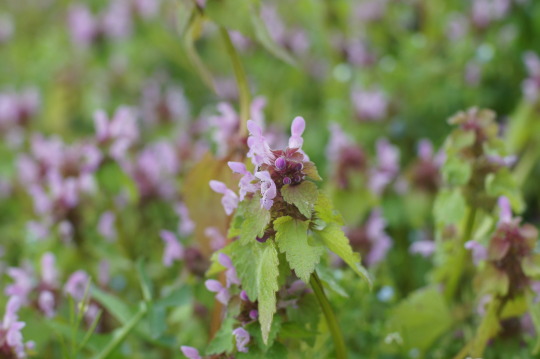
Dead nettle was the star of the wildflowers! It was everywhere and I was so joyful to see all kinds of bees -especially bumblebees- buzzing around in cold March days. It's an edible plant with lots of healing properties.
///
Işte bahçedeki yabani çiçeklerin yıldızı ballıbaba! Bir anda heryerde çıktı,büyüdü ve çiçek açtı! Çeşit çeşit arıları vızır vızır çiçeklerinde gezinirken görmek soğuk Mart günlerinde neşeme neşe kattı! Ballıbaba yenebilir bir bitki ve saymakla bitmeyen tıbbi özellikleri var.
Cardamine hirsuta (Bittercress) // Acıtere
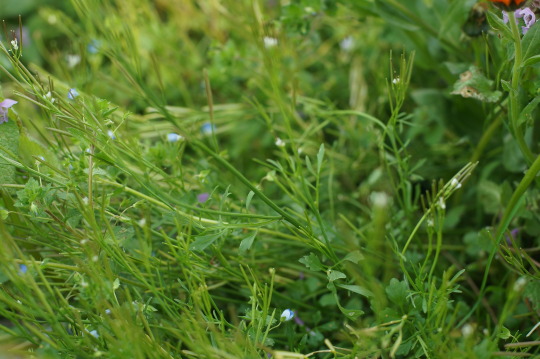
With its curly little leaves and tiny white flowers it was growing all around! It's edible and very pretty. It has a funny way of dispersing its seeds. Once the seedpods are dry, as soon as you touch them the seeds fly all over the place! At first I thought they were tiny little insects that were jumping around,but no! They were the jumping seeds!
///////
Acıtere kıvır kıvır yaprakları ve minik beyaz çiçekleriyle bahçenin her yanında belirdi! Yenebilir yaprakları olan şirin bir bitki. Tohumlarını çok komik bir yolla saçıyor. Tohum keseleri kuruyup iyice olgunlaştığında, dokunur dokunmaz tohumlar dört bir yana uçmaya başlıyor! İlk başta ne olduğunu anlamadım ,acaba ufak böcekler mi zıplıyor dedim ama hayır! Zıplayan tohumlardı bunlar! Böylelikle bahçedeki yerini garantiye almış oldu acıterecik.
Veronica persica (speedwell) // Mavişotu, cırcamuk
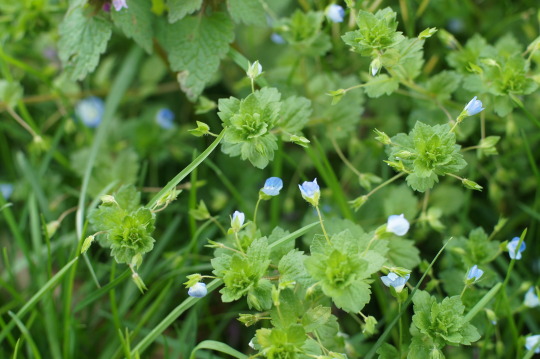
It almost took over the lawn.It's a creeping plant,a great ground cover and has tiny blue flowers which bees love! I just learned from juliasedibleweeds.com that Gypsies use this plant as a blood purifier. It also heals eyesores,removes excess mucus,soothes internal tissues,treats asthma,coughs..wow!
//////
Bu bitki neredeyse çimi ele geçirdi. Yayılıcı, minik mavi çiçekleri olan güzel bir bitki. Çiçekleri çok küçük olmasına rağmen arılar onu çok seviyor. Bu blog'tan öğrendiğime göre çingeneler mavişotunu kan temizleyici olarak kullanıyorlarmış.Üstelik göz enfeksiyonlarına iyi gelmesinin yanı sıra balgam söktürücü, doku iyileştirici, astımı ve öksürükleri dindirici etkileri varmış...vay be!
St.John's Wort (hypericum perforatum ) // Sarı Kantaron

I see it here and there and I keep it in protection. It's one of my favorite plants! I use its flowers for making an infused oil that I use for making salves. It heals burns and scrapes with incredible speed,like magic! Also an infused tea made of its flowers is an anti-depressant.It cheers you up without even noticing it!
When it's not flowering it develops roots and gives out shoots all round, which makes it a great ground cover.
///////
Bahçenin orasında burasında sarı kantaron bitkisini görüyorum ve hemen koruma altına alıyorum. En sevdiğim bitkilerden birisidir kendisi! Çiçeklerini zeytinyağında bekletip, o yağdan merhem yapıyorum.Yanıkları,kesikleri inanılmaz,sihirli bir hızla iyileştiriyor! Çiçeklerinden demlenen çay da depresyona çok iyi geliyor.Farkına bile varmadan bir bakmışsınız ki yerinizde dans etmeye başlamışsınız!
Bu bitki çiçek açmadığı zaman gücünü köklerine ve etrafa yayılmaya veriyor, bu da çim alanını azaltmak için güzel bir özellik.
Muscari armeniacum (grape hyacinth) // Arap sümbülü

In winter I noticed dark green allium like shoots coming up around the borders of the garden and I let them grow to see what will come out of them. At the end of March small flowers came up and there it was: grape hyacinth! It's such a delicate flower and YES it was also a native plant!
It's wonderful to see how many beautiful and beneficial plants lay underneath the boring lawn!
//////////
Kışın bahçenin kenar kısımlarında çıkan,koyu yeşil soğansı filizler dikkatimi çekti.Bıraktım büyüsünler ki çiçek açınca ne olduklarını anlayayım. Mart sonunda minik mor çiçekleri açtı ve anladım ki bu arap sümbülüymüş! O kadar kibar bir bitki ki...ve EVET o da yerel bir tür!
Çimin altında yatan onlarca güzel ve yararlı bitkiyle karşılaşmak harika bir his!
#permaculture#permaculturegarden#sustainable#sustainable living#perennial plants#artichoke#comfrey#daffodils#garden#sustainable gardening#tree guild#lamium purpureum#bittercress#weeds#medicinal herbs#groundcover plants#st john's wort#hypericum perforatum#veronica persica#growing#plants#Symphytum orientale#permakültür#sürdürülebilir bahçe#sürdürülebilirlik#ağaç birliği#tıbbi bitkiler#yabani bitkiler#permakültür bahçesi#ağaç birlikteliği
181 notes
·
View notes